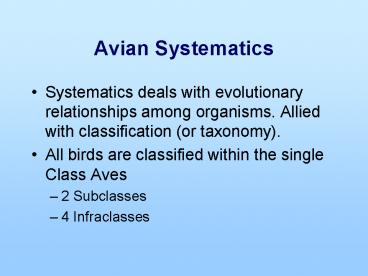Avian Systematics - PowerPoint PPT Presentation
1 / 20
Title:
Avian Systematics
Description:
Avian Systematics Systematics deals with evolutionary relationships among organisms. Allied with classification (or taxonomy). All birds are classified within the ... – PowerPoint PPT presentation
Number of Views:205
Avg rating:3.0/5.0
Title: Avian Systematics
1
Avian Systematics
- Systematics deals with evolutionary relationships
among organisms. Allied with classification (or
taxonomy). - All birds are classified within the single Class
Aves - 2 Subclasses
- 4 Infraclasses
2
Class Aves
- Subclass Sauriurae
- Infraclass Archaeornithes - Archaeopteryx
- Infraclass Enantiornithes - Opposite birds
- Subclass Ornithurae
- Infraclass Odontornithes - New World toothed
birds - Infraclass Neornithes
- Superorder Paleognathae - ratites and tinamous
- Superorder Neognathae - all other birds
3
Avian Phylogeny based on Feduccia (1995)
4
Avian Systematics
- Living birds comprise approximately
- 30 Orders
- 193 Families
- 2,099 Genera
- 9,700 species
5
Avian Systematics
- Basic unit of classification Species
- Biological Species Concept a species is a group
of similar looking individuals that are capable
of interbreeding successfully - Molecular Species Concept a species is a group
of organisms that are diagnosably different
genetically from other groups of organisms
6
Avian Systematics
- In practice, it can be difficult to delineate
species from subspecies (geographical variants)
by both definitions of species. - 2 Schools of Thought on differentiating species
- Lumpers tend to group similar forms into a
single species - Splitters tend to differentiate species when
only minor variation present
7
Avian Systematics
- The goal of systematics (and classification) is
to provide a correct phylogeny (evolutionary
family tree) for organisms. - Avian systematics deals with how the phylogeny of
modern birds is established.
8
Bases for Classification
- Morphology physical characteristics
- historical method by which phylogenies derived
- still a common method, particularly for fossil
birds - Biochemical Evidence closely related birds
should have more similar genes than more
distantly related birds - Supplementary Evidence
9
Morphology
- Physical characteristics used for establishing
phylogenies must be shared derived characters,
rather than primitive characters. - If two birds share a derived character, we can
hypothesize that they shared a common ancestor
with that same derived character.
10
Morphology
- Cladistics a method of using a number of
characters to establish a cladogram, which
presumably outlines the evolutionary
relationships among species based on these
characters. - Caution a cladogram is only as good as the
characters that are put into it, so careful
choice must be used in entering characters into
the model.
11
(No Transcript)
12
Morphology
- Morphological evidence alone is not sufficient to
derive correct phylogenies. - One problem is convergent evolution two species
which are not closely related may look similar
because they are adapted to similar lifestyles or
environments. - Examples
- Auks (N hemisphere) vs. Penguins (S hemisphere)
- New World Warblers and Australian Thornbills
13
Penguins southern Hemisphere
Auks northern Hemisphere
14
New World Warblers
Australian Warblers/Thornbills
15
Biochemical Evidence
- Protein Electorphoresis method of separating
proteins in an electric field depending on their
charge, which reflects their amino acid sequence. - Ideally, this should measure the genetic distance
between 2 birds, because the amino acid sequence
is dependent on the DNA sequence. - Not used much anymore.
16
Biochemical Evidence
- DNA/DNA Hybridization also an attempt to
measure amount of genetic similarity. More direct
than using proteins. - Fragments of single stranded DNA from 2 species
associated under specific conditions. Forms
2-stranded hybrid complex. - Hybrid complex then heated until dissociation.
- Higher numbers of shared base pairs lead to
increased thermal stability, so the more similar
the DNA, the higher the heat required for
dissociation.
17
Biochemical Evidence
- Problems with DNA/DNA Hybridization
- Differences may reflect adaptive radiation (and
associated rapid DNA change) rather than distant
ancestry - Natural selection acts on phenotype not on
genotype (convergence is also possible within
DNA) - There is some argument over how accurately
thermal stability reflects actual DNA sequences. - DNA/DNA hybridization not used much anymore.
18
Biochemical Evidence
- DNA Sequencing measures genetic similarity of a
portion of the genome (usually certain specific
genes) directly. - Measures nucleotide sequences of certain genes
directly (often use mitochondrial DNA) - Most direct measure of genetic similarity and the
common method for deriving phylogenies currently. - Usually will use several genes to verify
phylogeny.
19
Supplementary Evidence
- Behavior related species should show similar
unique (derived) behaviors - Example New World Vultures historically assigned
to Falconiformes based on morphology. Share
unique habit of urinating on legs to increase
heat loss when hot with storks (Ciconiiformes).
DNA evidence supports relationship with storks. - Biogeography ranges of closely related forms
should be geographically closer than more
distantly related forms.
20
Supplementary Evidence
- Karyotypes shapes and numbers of chromosomes.
Again, should be most similar between closely
related species. - Ectoparasites external parasites are often
specific for a particular species of bird.
Closely related birds should have similar
ectoparasites since they evolved along with the
birds. - TAKE HOME systematics is not a static science,
but is dynamic, changing as new information comes
to light.































![[PDF]❤️Download ⚡️ Avian Immunology 3rd Edition, Kindle Edition PowerPoint PPT Presentation](https://s3.amazonaws.com/images.powershow.com/10074217.th0.jpg?_=20240708124)